Promoting Sexual Health in School-Age Children: A Review of the Literature
VerifiedAdded on 2019/12/03
|12
|4446
|250
Report
AI Summary
The provided content discusses various aspects of promoting sexual health in school-age children and young adults. The articles focus on the use of online platforms, social media, and mobile technology to increase awareness about sexually transmitted infections (STIs) such as chlamydia. Additionally, the importance of screening and testing is highlighted. Other topics include the need for training in sexology, the development of risk scoring tools, and the role of local government in tackling STIs. Overall, the content emphasizes the importance of promoting sexual health through innovative and accessible means.
Contribute Materials
Your contribution can guide someone’s learning journey. Share your
documents today.
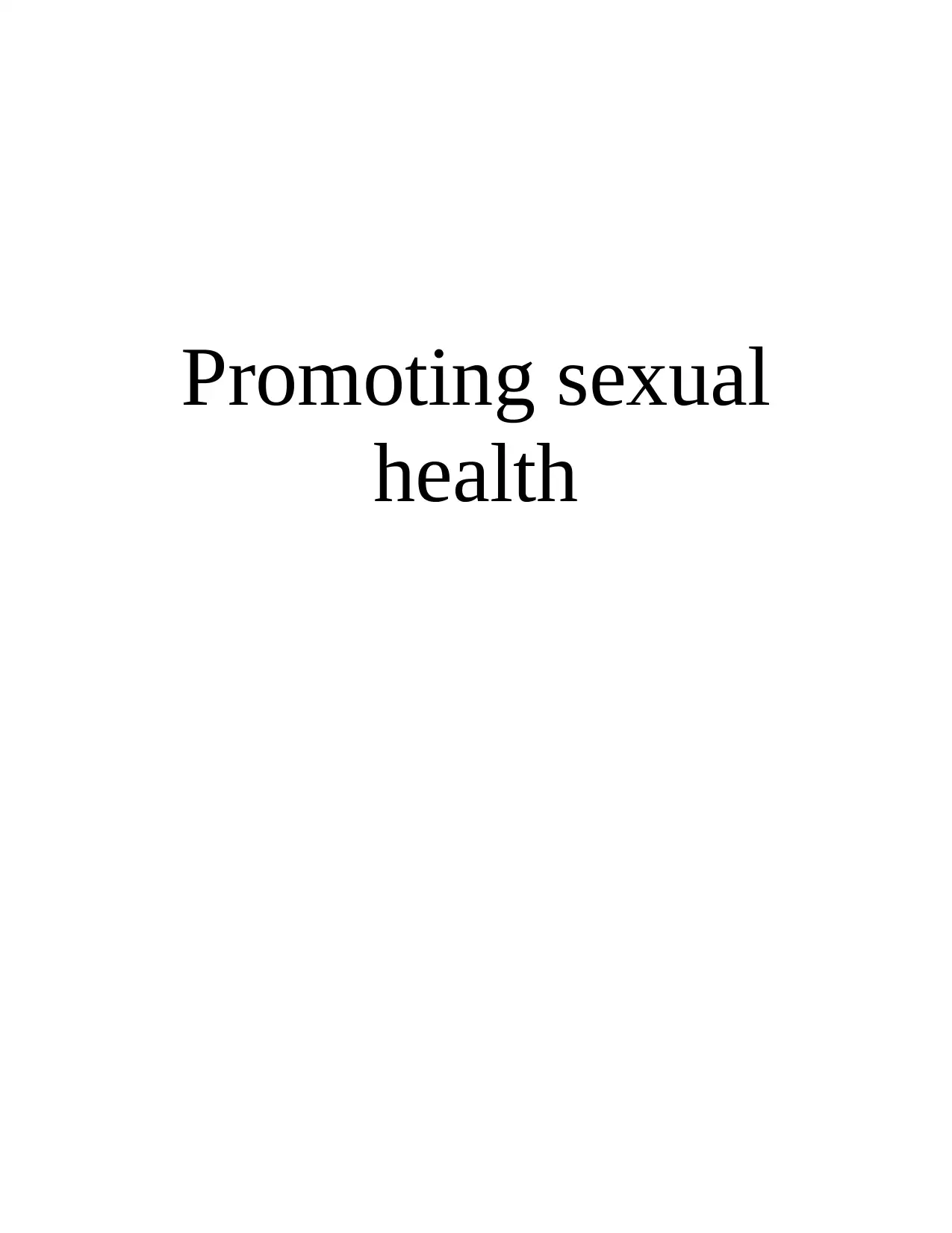
Promoting sexual
health
health
Secure Best Marks with AI Grader
Need help grading? Try our AI Grader for instant feedback on your assignments.
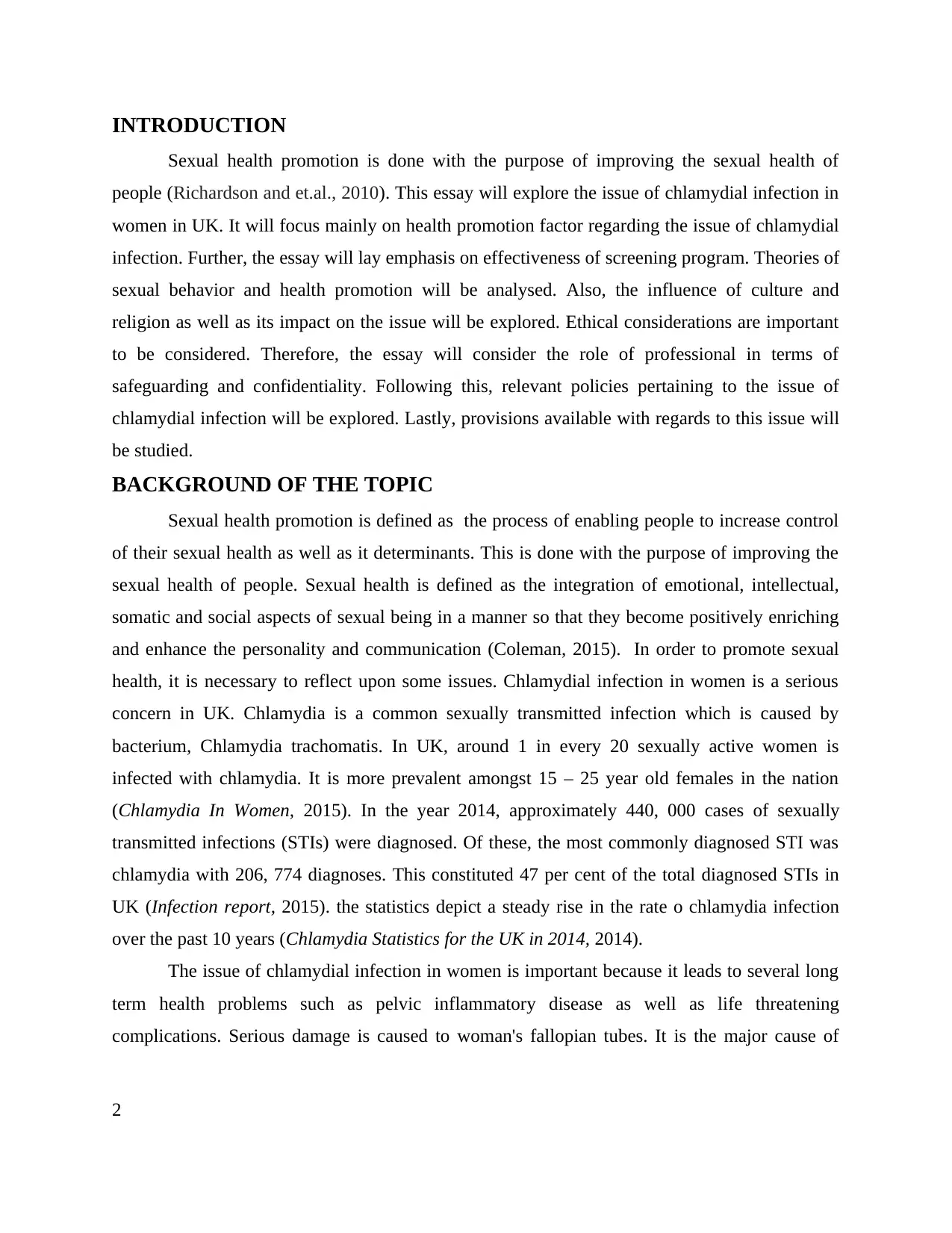
INTRODUCTION
Sexual health promotion is done with the purpose of improving the sexual health of
people (Richardson and et.al., 2010). This essay will explore the issue of chlamydial infection in
women in UK. It will focus mainly on health promotion factor regarding the issue of chlamydial
infection. Further, the essay will lay emphasis on effectiveness of screening program. Theories of
sexual behavior and health promotion will be analysed. Also, the influence of culture and
religion as well as its impact on the issue will be explored. Ethical considerations are important
to be considered. Therefore, the essay will consider the role of professional in terms of
safeguarding and confidentiality. Following this, relevant policies pertaining to the issue of
chlamydial infection will be explored. Lastly, provisions available with regards to this issue will
be studied.
BACKGROUND OF THE TOPIC
Sexual health promotion is defined as the process of enabling people to increase control
of their sexual health as well as it determinants. This is done with the purpose of improving the
sexual health of people. Sexual health is defined as the integration of emotional, intellectual,
somatic and social aspects of sexual being in a manner so that they become positively enriching
and enhance the personality and communication (Coleman, 2015). In order to promote sexual
health, it is necessary to reflect upon some issues. Chlamydial infection in women is a serious
concern in UK. Chlamydia is a common sexually transmitted infection which is caused by
bacterium, Chlamydia trachomatis. In UK, around 1 in every 20 sexually active women is
infected with chlamydia. It is more prevalent amongst 15 – 25 year old females in the nation
(Chlamydia In Women, 2015). In the year 2014, approximately 440, 000 cases of sexually
transmitted infections (STIs) were diagnosed. Of these, the most commonly diagnosed STI was
chlamydia with 206, 774 diagnoses. This constituted 47 per cent of the total diagnosed STIs in
UK (Infection report, 2015). the statistics depict a steady rise in the rate o chlamydia infection
over the past 10 years (Chlamydia Statistics for the UK in 2014, 2014).
The issue of chlamydial infection in women is important because it leads to several long
term health problems such as pelvic inflammatory disease as well as life threatening
complications. Serious damage is caused to woman's fallopian tubes. It is the major cause of
2
Sexual health promotion is done with the purpose of improving the sexual health of
people (Richardson and et.al., 2010). This essay will explore the issue of chlamydial infection in
women in UK. It will focus mainly on health promotion factor regarding the issue of chlamydial
infection. Further, the essay will lay emphasis on effectiveness of screening program. Theories of
sexual behavior and health promotion will be analysed. Also, the influence of culture and
religion as well as its impact on the issue will be explored. Ethical considerations are important
to be considered. Therefore, the essay will consider the role of professional in terms of
safeguarding and confidentiality. Following this, relevant policies pertaining to the issue of
chlamydial infection will be explored. Lastly, provisions available with regards to this issue will
be studied.
BACKGROUND OF THE TOPIC
Sexual health promotion is defined as the process of enabling people to increase control
of their sexual health as well as it determinants. This is done with the purpose of improving the
sexual health of people. Sexual health is defined as the integration of emotional, intellectual,
somatic and social aspects of sexual being in a manner so that they become positively enriching
and enhance the personality and communication (Coleman, 2015). In order to promote sexual
health, it is necessary to reflect upon some issues. Chlamydial infection in women is a serious
concern in UK. Chlamydia is a common sexually transmitted infection which is caused by
bacterium, Chlamydia trachomatis. In UK, around 1 in every 20 sexually active women is
infected with chlamydia. It is more prevalent amongst 15 – 25 year old females in the nation
(Chlamydia In Women, 2015). In the year 2014, approximately 440, 000 cases of sexually
transmitted infections (STIs) were diagnosed. Of these, the most commonly diagnosed STI was
chlamydia with 206, 774 diagnoses. This constituted 47 per cent of the total diagnosed STIs in
UK (Infection report, 2015). the statistics depict a steady rise in the rate o chlamydia infection
over the past 10 years (Chlamydia Statistics for the UK in 2014, 2014).
The issue of chlamydial infection in women is important because it leads to several long
term health problems such as pelvic inflammatory disease as well as life threatening
complications. Serious damage is caused to woman's fallopian tubes. It is the major cause of
2
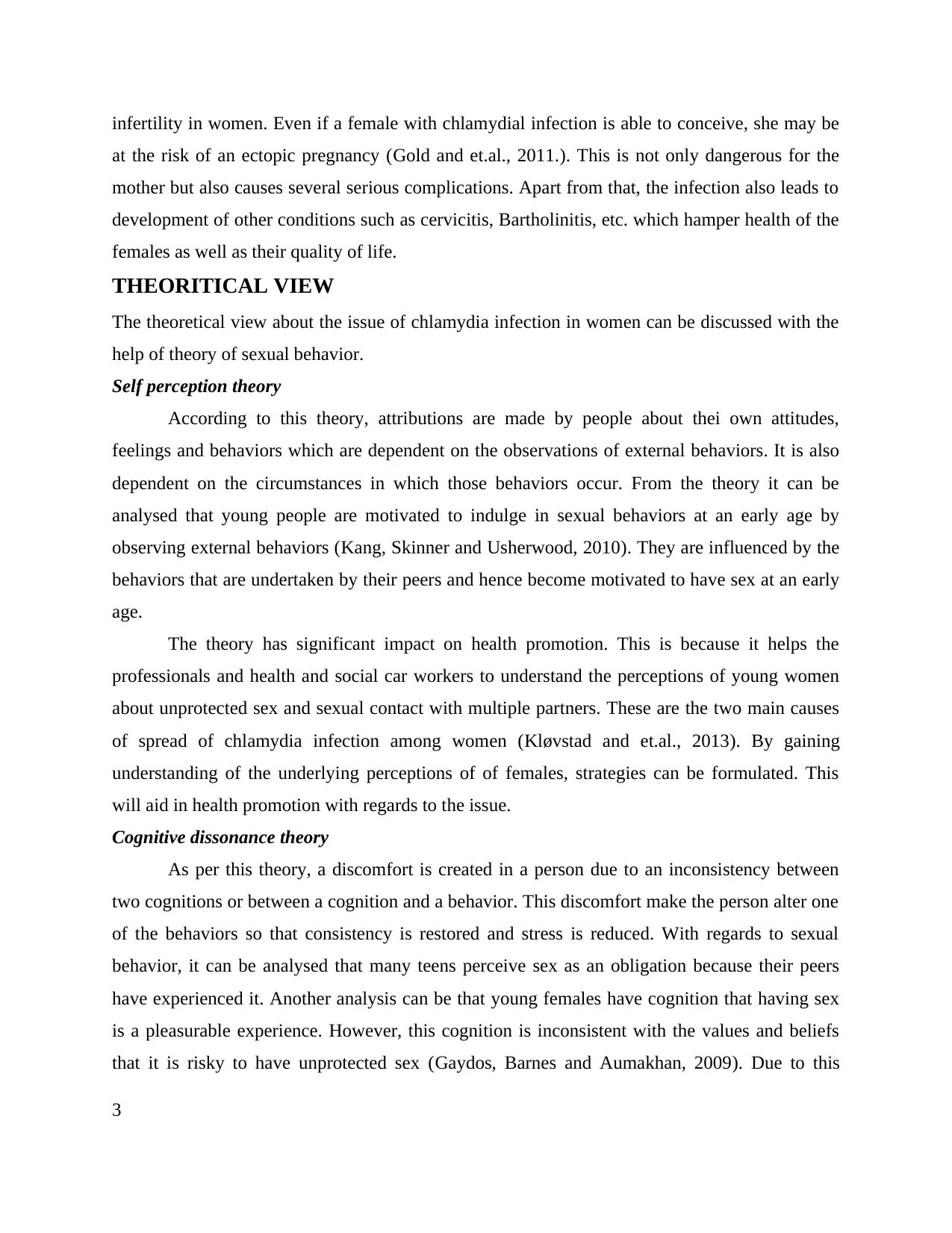
infertility in women. Even if a female with chlamydial infection is able to conceive, she may be
at the risk of an ectopic pregnancy (Gold and et.al., 2011.). This is not only dangerous for the
mother but also causes several serious complications. Apart from that, the infection also leads to
development of other conditions such as cervicitis, Bartholinitis, etc. which hamper health of the
females as well as their quality of life.
THEORITICAL VIEW
The theoretical view about the issue of chlamydia infection in women can be discussed with the
help of theory of sexual behavior.
Self perception theory
According to this theory, attributions are made by people about thei own attitudes,
feelings and behaviors which are dependent on the observations of external behaviors. It is also
dependent on the circumstances in which those behaviors occur. From the theory it can be
analysed that young people are motivated to indulge in sexual behaviors at an early age by
observing external behaviors (Kang, Skinner and Usherwood, 2010). They are influenced by the
behaviors that are undertaken by their peers and hence become motivated to have sex at an early
age.
The theory has significant impact on health promotion. This is because it helps the
professionals and health and social car workers to understand the perceptions of young women
about unprotected sex and sexual contact with multiple partners. These are the two main causes
of spread of chlamydia infection among women (Kløvstad and et.al., 2013). By gaining
understanding of the underlying perceptions of of females, strategies can be formulated. This
will aid in health promotion with regards to the issue.
Cognitive dissonance theory
As per this theory, a discomfort is created in a person due to an inconsistency between
two cognitions or between a cognition and a behavior. This discomfort make the person alter one
of the behaviors so that consistency is restored and stress is reduced. With regards to sexual
behavior, it can be analysed that many teens perceive sex as an obligation because their peers
have experienced it. Another analysis can be that young females have cognition that having sex
is a pleasurable experience. However, this cognition is inconsistent with the values and beliefs
that it is risky to have unprotected sex (Gaydos, Barnes and Aumakhan, 2009). Due to this
3
at the risk of an ectopic pregnancy (Gold and et.al., 2011.). This is not only dangerous for the
mother but also causes several serious complications. Apart from that, the infection also leads to
development of other conditions such as cervicitis, Bartholinitis, etc. which hamper health of the
females as well as their quality of life.
THEORITICAL VIEW
The theoretical view about the issue of chlamydia infection in women can be discussed with the
help of theory of sexual behavior.
Self perception theory
According to this theory, attributions are made by people about thei own attitudes,
feelings and behaviors which are dependent on the observations of external behaviors. It is also
dependent on the circumstances in which those behaviors occur. From the theory it can be
analysed that young people are motivated to indulge in sexual behaviors at an early age by
observing external behaviors (Kang, Skinner and Usherwood, 2010). They are influenced by the
behaviors that are undertaken by their peers and hence become motivated to have sex at an early
age.
The theory has significant impact on health promotion. This is because it helps the
professionals and health and social car workers to understand the perceptions of young women
about unprotected sex and sexual contact with multiple partners. These are the two main causes
of spread of chlamydia infection among women (Kløvstad and et.al., 2013). By gaining
understanding of the underlying perceptions of of females, strategies can be formulated. This
will aid in health promotion with regards to the issue.
Cognitive dissonance theory
As per this theory, a discomfort is created in a person due to an inconsistency between
two cognitions or between a cognition and a behavior. This discomfort make the person alter one
of the behaviors so that consistency is restored and stress is reduced. With regards to sexual
behavior, it can be analysed that many teens perceive sex as an obligation because their peers
have experienced it. Another analysis can be that young females have cognition that having sex
is a pleasurable experience. However, this cognition is inconsistent with the values and beliefs
that it is risky to have unprotected sex (Gaydos, Barnes and Aumakhan, 2009). Due to this
3
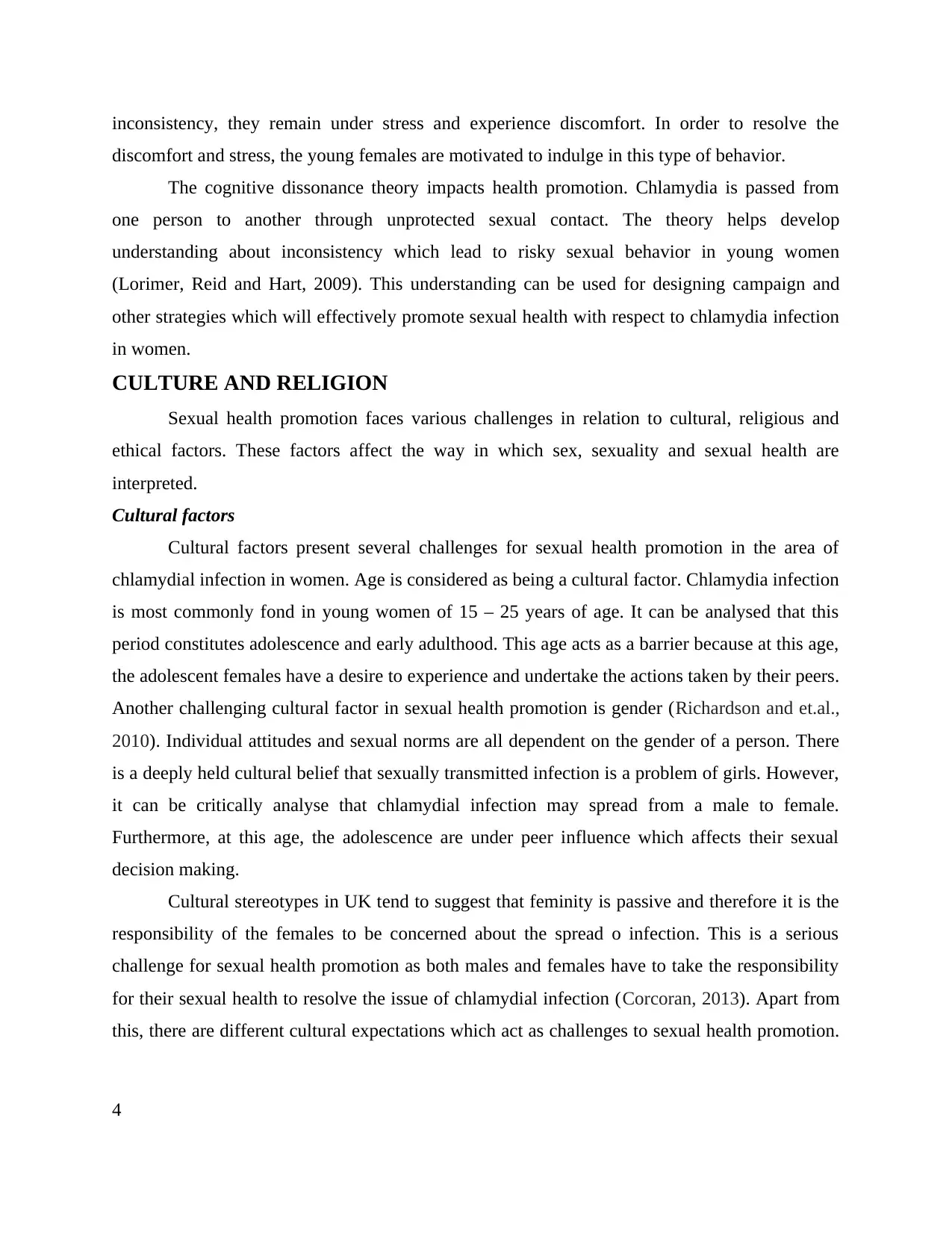
inconsistency, they remain under stress and experience discomfort. In order to resolve the
discomfort and stress, the young females are motivated to indulge in this type of behavior.
The cognitive dissonance theory impacts health promotion. Chlamydia is passed from
one person to another through unprotected sexual contact. The theory helps develop
understanding about inconsistency which lead to risky sexual behavior in young women
(Lorimer, Reid and Hart, 2009). This understanding can be used for designing campaign and
other strategies which will effectively promote sexual health with respect to chlamydia infection
in women.
CULTURE AND RELIGION
Sexual health promotion faces various challenges in relation to cultural, religious and
ethical factors. These factors affect the way in which sex, sexuality and sexual health are
interpreted.
Cultural factors
Cultural factors present several challenges for sexual health promotion in the area of
chlamydial infection in women. Age is considered as being a cultural factor. Chlamydia infection
is most commonly fond in young women of 15 – 25 years of age. It can be analysed that this
period constitutes adolescence and early adulthood. This age acts as a barrier because at this age,
the adolescent females have a desire to experience and undertake the actions taken by their peers.
Another challenging cultural factor in sexual health promotion is gender (Richardson and et.al.,
2010). Individual attitudes and sexual norms are all dependent on the gender of a person. There
is a deeply held cultural belief that sexually transmitted infection is a problem of girls. However,
it can be critically analyse that chlamydial infection may spread from a male to female.
Furthermore, at this age, the adolescence are under peer influence which affects their sexual
decision making.
Cultural stereotypes in UK tend to suggest that feminity is passive and therefore it is the
responsibility of the females to be concerned about the spread o infection. This is a serious
challenge for sexual health promotion as both males and females have to take the responsibility
for their sexual health to resolve the issue of chlamydial infection (Corcoran, 2013). Apart from
this, there are different cultural expectations which act as challenges to sexual health promotion.
4
discomfort and stress, the young females are motivated to indulge in this type of behavior.
The cognitive dissonance theory impacts health promotion. Chlamydia is passed from
one person to another through unprotected sexual contact. The theory helps develop
understanding about inconsistency which lead to risky sexual behavior in young women
(Lorimer, Reid and Hart, 2009). This understanding can be used for designing campaign and
other strategies which will effectively promote sexual health with respect to chlamydia infection
in women.
CULTURE AND RELIGION
Sexual health promotion faces various challenges in relation to cultural, religious and
ethical factors. These factors affect the way in which sex, sexuality and sexual health are
interpreted.
Cultural factors
Cultural factors present several challenges for sexual health promotion in the area of
chlamydial infection in women. Age is considered as being a cultural factor. Chlamydia infection
is most commonly fond in young women of 15 – 25 years of age. It can be analysed that this
period constitutes adolescence and early adulthood. This age acts as a barrier because at this age,
the adolescent females have a desire to experience and undertake the actions taken by their peers.
Another challenging cultural factor in sexual health promotion is gender (Richardson and et.al.,
2010). Individual attitudes and sexual norms are all dependent on the gender of a person. There
is a deeply held cultural belief that sexually transmitted infection is a problem of girls. However,
it can be critically analyse that chlamydial infection may spread from a male to female.
Furthermore, at this age, the adolescence are under peer influence which affects their sexual
decision making.
Cultural stereotypes in UK tend to suggest that feminity is passive and therefore it is the
responsibility of the females to be concerned about the spread o infection. This is a serious
challenge for sexual health promotion as both males and females have to take the responsibility
for their sexual health to resolve the issue of chlamydial infection (Corcoran, 2013). Apart from
this, there are different cultural expectations which act as challenges to sexual health promotion.
4
Secure Best Marks with AI Grader
Need help grading? Try our AI Grader for instant feedback on your assignments.
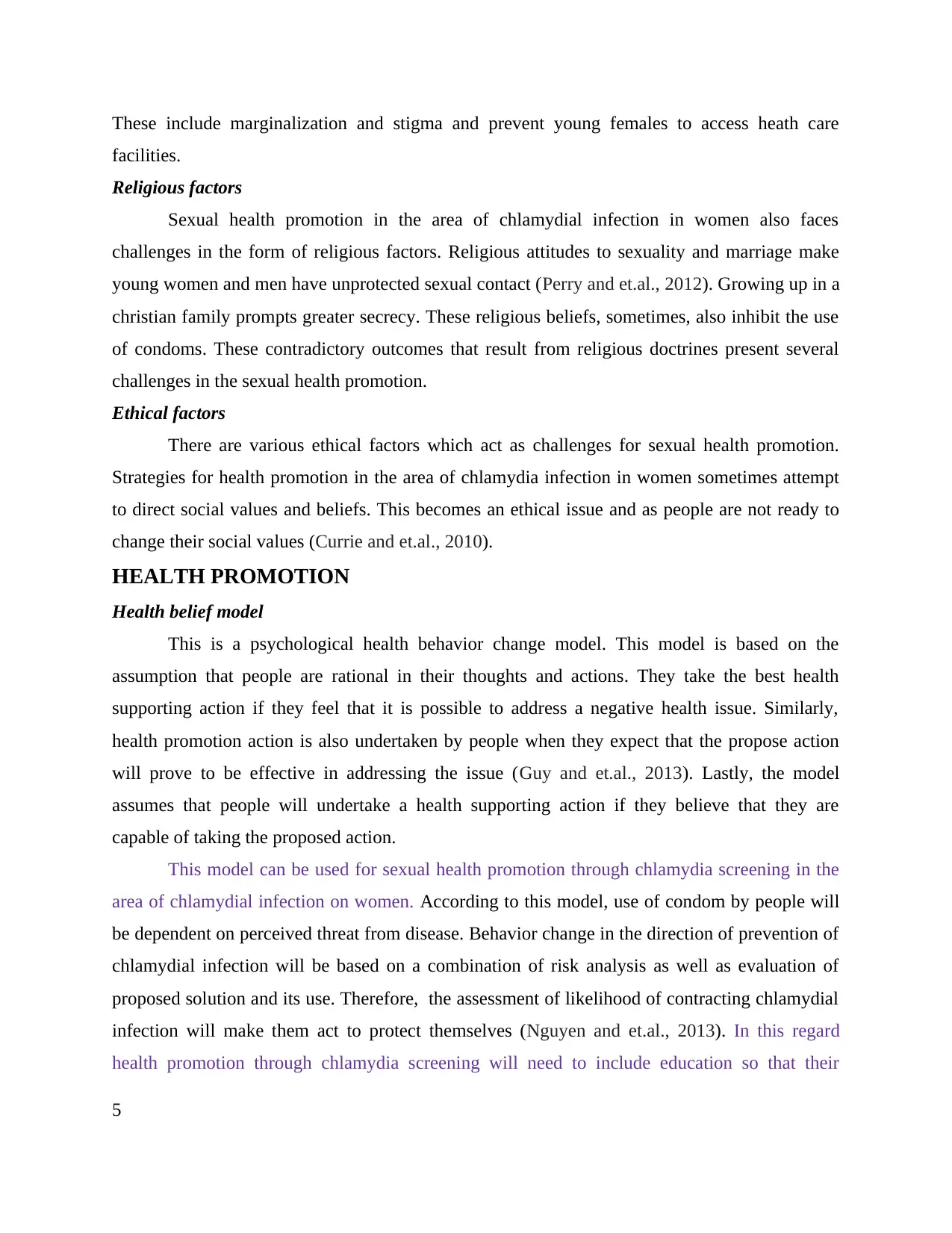
These include marginalization and stigma and prevent young females to access heath care
facilities.
Religious factors
Sexual health promotion in the area of chlamydial infection in women also faces
challenges in the form of religious factors. Religious attitudes to sexuality and marriage make
young women and men have unprotected sexual contact (Perry and et.al., 2012). Growing up in a
christian family prompts greater secrecy. These religious beliefs, sometimes, also inhibit the use
of condoms. These contradictory outcomes that result from religious doctrines present several
challenges in the sexual health promotion.
Ethical factors
There are various ethical factors which act as challenges for sexual health promotion.
Strategies for health promotion in the area of chlamydia infection in women sometimes attempt
to direct social values and beliefs. This becomes an ethical issue and as people are not ready to
change their social values (Currie and et.al., 2010).
HEALTH PROMOTION
Health belief model
This is a psychological health behavior change model. This model is based on the
assumption that people are rational in their thoughts and actions. They take the best health
supporting action if they feel that it is possible to address a negative health issue. Similarly,
health promotion action is also undertaken by people when they expect that the propose action
will prove to be effective in addressing the issue (Guy and et.al., 2013). Lastly, the model
assumes that people will undertake a health supporting action if they believe that they are
capable of taking the proposed action.
This model can be used for sexual health promotion through chlamydia screening in the
area of chlamydial infection on women. According to this model, use of condom by people will
be dependent on perceived threat from disease. Behavior change in the direction of prevention of
chlamydial infection will be based on a combination of risk analysis as well as evaluation of
proposed solution and its use. Therefore, the assessment of likelihood of contracting chlamydial
infection will make them act to protect themselves (Nguyen and et.al., 2013). In this regard
health promotion through chlamydia screening will need to include education so that their
5
facilities.
Religious factors
Sexual health promotion in the area of chlamydial infection in women also faces
challenges in the form of religious factors. Religious attitudes to sexuality and marriage make
young women and men have unprotected sexual contact (Perry and et.al., 2012). Growing up in a
christian family prompts greater secrecy. These religious beliefs, sometimes, also inhibit the use
of condoms. These contradictory outcomes that result from religious doctrines present several
challenges in the sexual health promotion.
Ethical factors
There are various ethical factors which act as challenges for sexual health promotion.
Strategies for health promotion in the area of chlamydia infection in women sometimes attempt
to direct social values and beliefs. This becomes an ethical issue and as people are not ready to
change their social values (Currie and et.al., 2010).
HEALTH PROMOTION
Health belief model
This is a psychological health behavior change model. This model is based on the
assumption that people are rational in their thoughts and actions. They take the best health
supporting action if they feel that it is possible to address a negative health issue. Similarly,
health promotion action is also undertaken by people when they expect that the propose action
will prove to be effective in addressing the issue (Guy and et.al., 2013). Lastly, the model
assumes that people will undertake a health supporting action if they believe that they are
capable of taking the proposed action.
This model can be used for sexual health promotion through chlamydia screening in the
area of chlamydial infection on women. According to this model, use of condom by people will
be dependent on perceived threat from disease. Behavior change in the direction of prevention of
chlamydial infection will be based on a combination of risk analysis as well as evaluation of
proposed solution and its use. Therefore, the assessment of likelihood of contracting chlamydial
infection will make them act to protect themselves (Nguyen and et.al., 2013). In this regard
health promotion through chlamydia screening will need to include education so that their
5
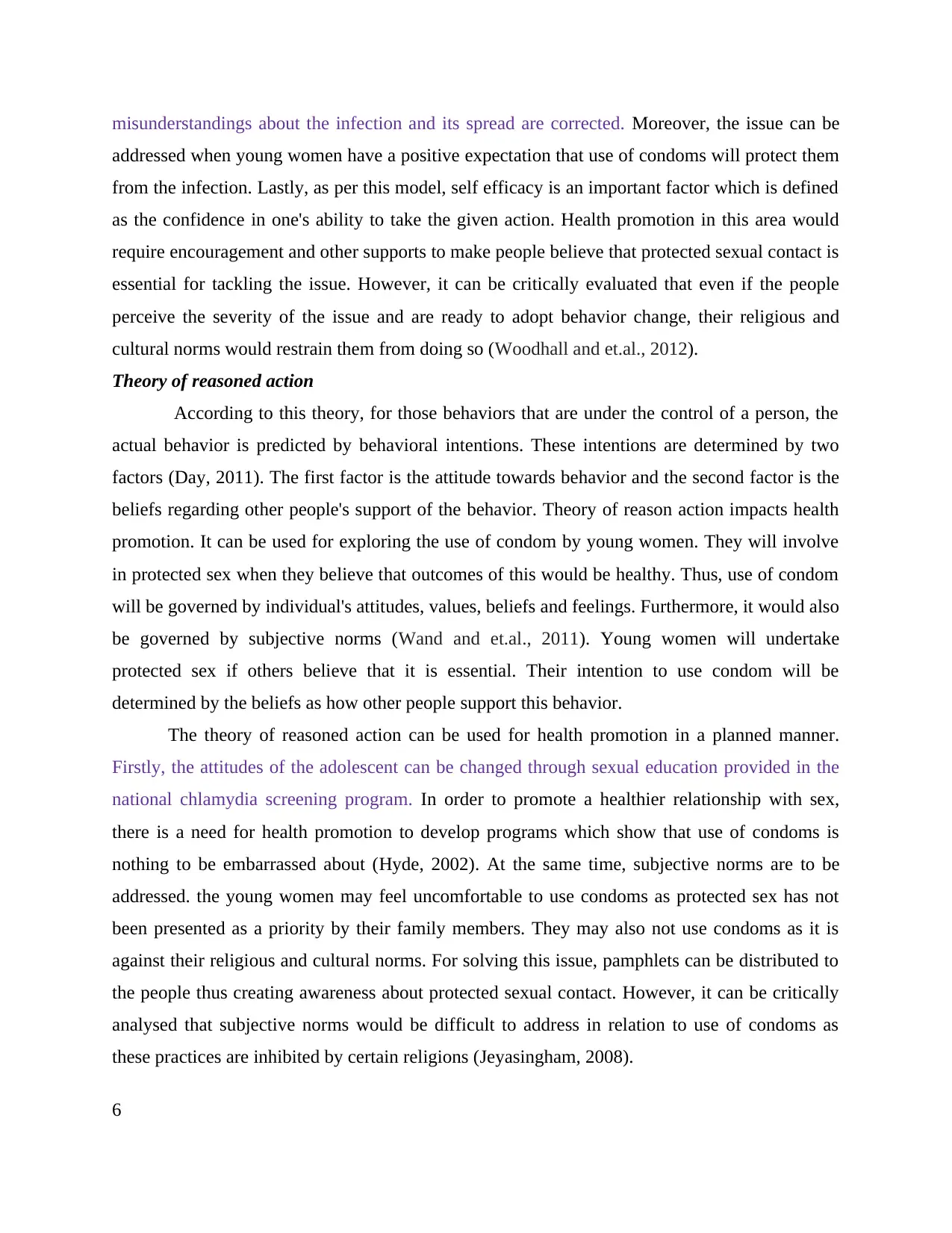
misunderstandings about the infection and its spread are corrected. Moreover, the issue can be
addressed when young women have a positive expectation that use of condoms will protect them
from the infection. Lastly, as per this model, self efficacy is an important factor which is defined
as the confidence in one's ability to take the given action. Health promotion in this area would
require encouragement and other supports to make people believe that protected sexual contact is
essential for tackling the issue. However, it can be critically evaluated that even if the people
perceive the severity of the issue and are ready to adopt behavior change, their religious and
cultural norms would restrain them from doing so (Woodhall and et.al., 2012).
Theory of reasoned action
According to this theory, for those behaviors that are under the control of a person, the
actual behavior is predicted by behavioral intentions. These intentions are determined by two
factors (Day, 2011). The first factor is the attitude towards behavior and the second factor is the
beliefs regarding other people's support of the behavior. Theory of reason action impacts health
promotion. It can be used for exploring the use of condom by young women. They will involve
in protected sex when they believe that outcomes of this would be healthy. Thus, use of condom
will be governed by individual's attitudes, values, beliefs and feelings. Furthermore, it would also
be governed by subjective norms (Wand and et.al., 2011). Young women will undertake
protected sex if others believe that it is essential. Their intention to use condom will be
determined by the beliefs as how other people support this behavior.
The theory of reasoned action can be used for health promotion in a planned manner.
Firstly, the attitudes of the adolescent can be changed through sexual education provided in the
national chlamydia screening program. In order to promote a healthier relationship with sex,
there is a need for health promotion to develop programs which show that use of condoms is
nothing to be embarrassed about (Hyde, 2002). At the same time, subjective norms are to be
addressed. the young women may feel uncomfortable to use condoms as protected sex has not
been presented as a priority by their family members. They may also not use condoms as it is
against their religious and cultural norms. For solving this issue, pamphlets can be distributed to
the people thus creating awareness about protected sexual contact. However, it can be critically
analysed that subjective norms would be difficult to address in relation to use of condoms as
these practices are inhibited by certain religions (Jeyasingham, 2008).
6
addressed when young women have a positive expectation that use of condoms will protect them
from the infection. Lastly, as per this model, self efficacy is an important factor which is defined
as the confidence in one's ability to take the given action. Health promotion in this area would
require encouragement and other supports to make people believe that protected sexual contact is
essential for tackling the issue. However, it can be critically evaluated that even if the people
perceive the severity of the issue and are ready to adopt behavior change, their religious and
cultural norms would restrain them from doing so (Woodhall and et.al., 2012).
Theory of reasoned action
According to this theory, for those behaviors that are under the control of a person, the
actual behavior is predicted by behavioral intentions. These intentions are determined by two
factors (Day, 2011). The first factor is the attitude towards behavior and the second factor is the
beliefs regarding other people's support of the behavior. Theory of reason action impacts health
promotion. It can be used for exploring the use of condom by young women. They will involve
in protected sex when they believe that outcomes of this would be healthy. Thus, use of condom
will be governed by individual's attitudes, values, beliefs and feelings. Furthermore, it would also
be governed by subjective norms (Wand and et.al., 2011). Young women will undertake
protected sex if others believe that it is essential. Their intention to use condom will be
determined by the beliefs as how other people support this behavior.
The theory of reasoned action can be used for health promotion in a planned manner.
Firstly, the attitudes of the adolescent can be changed through sexual education provided in the
national chlamydia screening program. In order to promote a healthier relationship with sex,
there is a need for health promotion to develop programs which show that use of condoms is
nothing to be embarrassed about (Hyde, 2002). At the same time, subjective norms are to be
addressed. the young women may feel uncomfortable to use condoms as protected sex has not
been presented as a priority by their family members. They may also not use condoms as it is
against their religious and cultural norms. For solving this issue, pamphlets can be distributed to
the people thus creating awareness about protected sexual contact. However, it can be critically
analysed that subjective norms would be difficult to address in relation to use of condoms as
these practices are inhibited by certain religions (Jeyasingham, 2008).
6
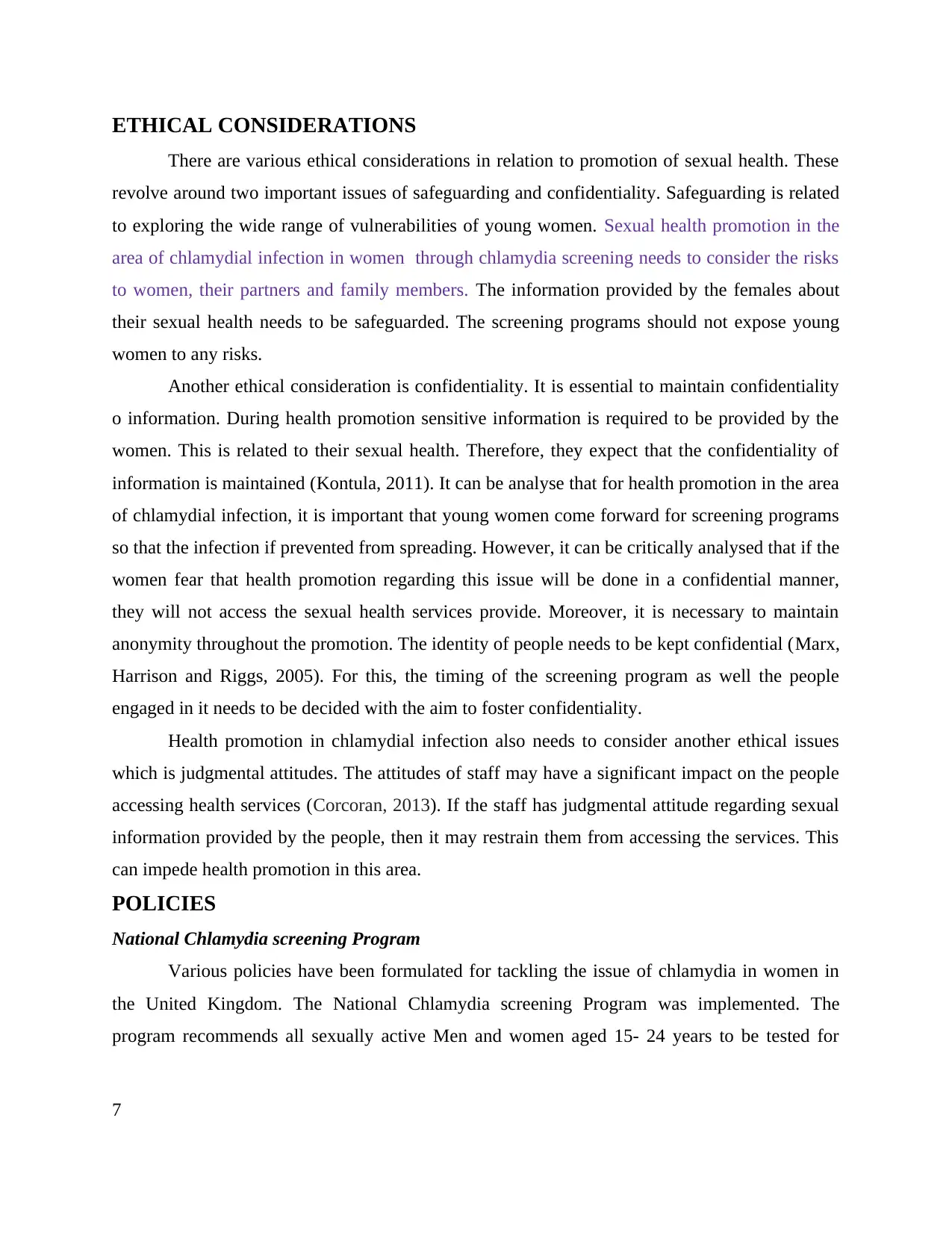
ETHICAL CONSIDERATIONS
There are various ethical considerations in relation to promotion of sexual health. These
revolve around two important issues of safeguarding and confidentiality. Safeguarding is related
to exploring the wide range of vulnerabilities of young women. Sexual health promotion in the
area of chlamydial infection in women through chlamydia screening needs to consider the risks
to women, their partners and family members. The information provided by the females about
their sexual health needs to be safeguarded. The screening programs should not expose young
women to any risks.
Another ethical consideration is confidentiality. It is essential to maintain confidentiality
o information. During health promotion sensitive information is required to be provided by the
women. This is related to their sexual health. Therefore, they expect that the confidentiality of
information is maintained (Kontula, 2011). It can be analyse that for health promotion in the area
of chlamydial infection, it is important that young women come forward for screening programs
so that the infection if prevented from spreading. However, it can be critically analysed that if the
women fear that health promotion regarding this issue will be done in a confidential manner,
they will not access the sexual health services provide. Moreover, it is necessary to maintain
anonymity throughout the promotion. The identity of people needs to be kept confidential (Marx,
Harrison and Riggs, 2005). For this, the timing of the screening program as well the people
engaged in it needs to be decided with the aim to foster confidentiality.
Health promotion in chlamydial infection also needs to consider another ethical issues
which is judgmental attitudes. The attitudes of staff may have a significant impact on the people
accessing health services (Corcoran, 2013). If the staff has judgmental attitude regarding sexual
information provided by the people, then it may restrain them from accessing the services. This
can impede health promotion in this area.
POLICIES
National Chlamydia screening Program
Various policies have been formulated for tackling the issue of chlamydia in women in
the United Kingdom. The National Chlamydia screening Program was implemented. The
program recommends all sexually active Men and women aged 15- 24 years to be tested for
7
There are various ethical considerations in relation to promotion of sexual health. These
revolve around two important issues of safeguarding and confidentiality. Safeguarding is related
to exploring the wide range of vulnerabilities of young women. Sexual health promotion in the
area of chlamydial infection in women through chlamydia screening needs to consider the risks
to women, their partners and family members. The information provided by the females about
their sexual health needs to be safeguarded. The screening programs should not expose young
women to any risks.
Another ethical consideration is confidentiality. It is essential to maintain confidentiality
o information. During health promotion sensitive information is required to be provided by the
women. This is related to their sexual health. Therefore, they expect that the confidentiality of
information is maintained (Kontula, 2011). It can be analyse that for health promotion in the area
of chlamydial infection, it is important that young women come forward for screening programs
so that the infection if prevented from spreading. However, it can be critically analysed that if the
women fear that health promotion regarding this issue will be done in a confidential manner,
they will not access the sexual health services provide. Moreover, it is necessary to maintain
anonymity throughout the promotion. The identity of people needs to be kept confidential (Marx,
Harrison and Riggs, 2005). For this, the timing of the screening program as well the people
engaged in it needs to be decided with the aim to foster confidentiality.
Health promotion in chlamydial infection also needs to consider another ethical issues
which is judgmental attitudes. The attitudes of staff may have a significant impact on the people
accessing health services (Corcoran, 2013). If the staff has judgmental attitude regarding sexual
information provided by the people, then it may restrain them from accessing the services. This
can impede health promotion in this area.
POLICIES
National Chlamydia screening Program
Various policies have been formulated for tackling the issue of chlamydia in women in
the United Kingdom. The National Chlamydia screening Program was implemented. The
program recommends all sexually active Men and women aged 15- 24 years to be tested for
7
Paraphrase This Document
Need a fresh take? Get an instant paraphrase of this document with our AI Paraphraser

chlamydia annually or on change of sexual partner (Tackling chlamydia, 2013). Chlamydia
screening includes a routine test which is carried out to detect the presence of chlamydia in a
person. Screening for chlamydia is commissioned as a part of comprehensive package o sexual
and reproductive health services. Treatment as well as prevention services are provided along
with the screening program. The screening is offered opportunistically (Tackling chlamydia,
2013). Young people who have attained the age of sexual maturation are offered a test when they
attend services such as community sexual and reproductive heath services, specialist
genitourinary medicine services, GPs etc.
It can be assessed that the policy is effective as it covers both men and women. It also
incorporates annual follow ups. This screening program also delivers information and support
which ensures that young people have the knowledge to protect themselves from sexually
transmitted infections. This policy intervention is also effective at empowering people to take
responsibility for their own health.
The policy is also effective at reducing the transmission of infection. Moreover, it makes
people aware about the consequences of untreated infection thus making them vigilant about
their own health (Gold and et.al., 2011). However, it can be critically analysed that the policy
does not comprise of effective interventions for bringing behavior change in the people. The
people may come for the screening, but, if behavior change is not initiated, the issue may not be
tackled holistically.
Chlamydia screening is an effective way which helps in identifying infected individuals
in the population (Kang, Skinner and Usherwood, 2010). Therefore, the screening not only
prevents transmission of infection but also also the reproductive problems which result in
transmission. When men and women are tested and infected individuals are identified, health
promotion materials and information can be delivered to them.
Attitudes of people towards Chlamydia screening
Young people who attend GP services have a positive attitude towards the chlamydia
screening. This assists in sexual health promotion in the area. However, it has been found that
most at risk group or chlamydia infection is not well educated about the risks (Day, 2011). Men's
attitude towards chlamydia screening is influenced by their knowledge about the infection,
degree of embarrassment, perceived vulnerability to infection and stigma associated with it.
8
screening includes a routine test which is carried out to detect the presence of chlamydia in a
person. Screening for chlamydia is commissioned as a part of comprehensive package o sexual
and reproductive health services. Treatment as well as prevention services are provided along
with the screening program. The screening is offered opportunistically (Tackling chlamydia,
2013). Young people who have attained the age of sexual maturation are offered a test when they
attend services such as community sexual and reproductive heath services, specialist
genitourinary medicine services, GPs etc.
It can be assessed that the policy is effective as it covers both men and women. It also
incorporates annual follow ups. This screening program also delivers information and support
which ensures that young people have the knowledge to protect themselves from sexually
transmitted infections. This policy intervention is also effective at empowering people to take
responsibility for their own health.
The policy is also effective at reducing the transmission of infection. Moreover, it makes
people aware about the consequences of untreated infection thus making them vigilant about
their own health (Gold and et.al., 2011). However, it can be critically analysed that the policy
does not comprise of effective interventions for bringing behavior change in the people. The
people may come for the screening, but, if behavior change is not initiated, the issue may not be
tackled holistically.
Chlamydia screening is an effective way which helps in identifying infected individuals
in the population (Kang, Skinner and Usherwood, 2010). Therefore, the screening not only
prevents transmission of infection but also also the reproductive problems which result in
transmission. When men and women are tested and infected individuals are identified, health
promotion materials and information can be delivered to them.
Attitudes of people towards Chlamydia screening
Young people who attend GP services have a positive attitude towards the chlamydia
screening. This assists in sexual health promotion in the area. However, it has been found that
most at risk group or chlamydia infection is not well educated about the risks (Day, 2011). Men's
attitude towards chlamydia screening is influenced by their knowledge about the infection,
degree of embarrassment, perceived vulnerability to infection and stigma associated with it.
8
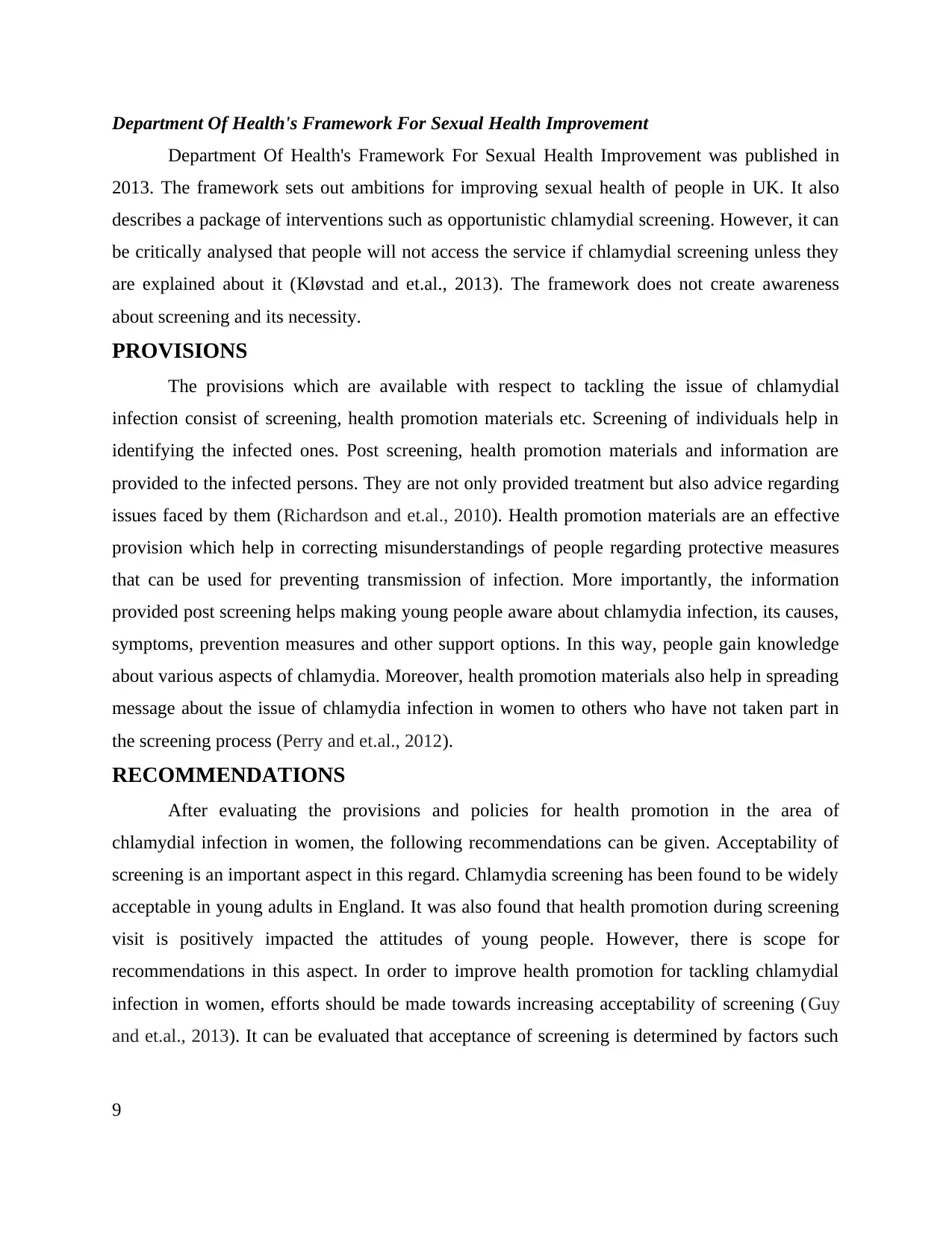
Department Of Health's Framework For Sexual Health Improvement
Department Of Health's Framework For Sexual Health Improvement was published in
2013. The framework sets out ambitions for improving sexual health of people in UK. It also
describes a package of interventions such as opportunistic chlamydial screening. However, it can
be critically analysed that people will not access the service if chlamydial screening unless they
are explained about it (Kløvstad and et.al., 2013). The framework does not create awareness
about screening and its necessity.
PROVISIONS
The provisions which are available with respect to tackling the issue of chlamydial
infection consist of screening, health promotion materials etc. Screening of individuals help in
identifying the infected ones. Post screening, health promotion materials and information are
provided to the infected persons. They are not only provided treatment but also advice regarding
issues faced by them (Richardson and et.al., 2010). Health promotion materials are an effective
provision which help in correcting misunderstandings of people regarding protective measures
that can be used for preventing transmission of infection. More importantly, the information
provided post screening helps making young people aware about chlamydia infection, its causes,
symptoms, prevention measures and other support options. In this way, people gain knowledge
about various aspects of chlamydia. Moreover, health promotion materials also help in spreading
message about the issue of chlamydia infection in women to others who have not taken part in
the screening process (Perry and et.al., 2012).
RECOMMENDATIONS
After evaluating the provisions and policies for health promotion in the area of
chlamydial infection in women, the following recommendations can be given. Acceptability of
screening is an important aspect in this regard. Chlamydia screening has been found to be widely
acceptable in young adults in England. It was also found that health promotion during screening
visit is positively impacted the attitudes of young people. However, there is scope for
recommendations in this aspect. In order to improve health promotion for tackling chlamydial
infection in women, efforts should be made towards increasing acceptability of screening (Guy
and et.al., 2013). It can be evaluated that acceptance of screening is determined by factors such
9
Department Of Health's Framework For Sexual Health Improvement was published in
2013. The framework sets out ambitions for improving sexual health of people in UK. It also
describes a package of interventions such as opportunistic chlamydial screening. However, it can
be critically analysed that people will not access the service if chlamydial screening unless they
are explained about it (Kløvstad and et.al., 2013). The framework does not create awareness
about screening and its necessity.
PROVISIONS
The provisions which are available with respect to tackling the issue of chlamydial
infection consist of screening, health promotion materials etc. Screening of individuals help in
identifying the infected ones. Post screening, health promotion materials and information are
provided to the infected persons. They are not only provided treatment but also advice regarding
issues faced by them (Richardson and et.al., 2010). Health promotion materials are an effective
provision which help in correcting misunderstandings of people regarding protective measures
that can be used for preventing transmission of infection. More importantly, the information
provided post screening helps making young people aware about chlamydia infection, its causes,
symptoms, prevention measures and other support options. In this way, people gain knowledge
about various aspects of chlamydia. Moreover, health promotion materials also help in spreading
message about the issue of chlamydia infection in women to others who have not taken part in
the screening process (Perry and et.al., 2012).
RECOMMENDATIONS
After evaluating the provisions and policies for health promotion in the area of
chlamydial infection in women, the following recommendations can be given. Acceptability of
screening is an important aspect in this regard. Chlamydia screening has been found to be widely
acceptable in young adults in England. It was also found that health promotion during screening
visit is positively impacted the attitudes of young people. However, there is scope for
recommendations in this aspect. In order to improve health promotion for tackling chlamydial
infection in women, efforts should be made towards increasing acceptability of screening (Guy
and et.al., 2013). It can be evaluated that acceptance of screening is determined by factors such
9
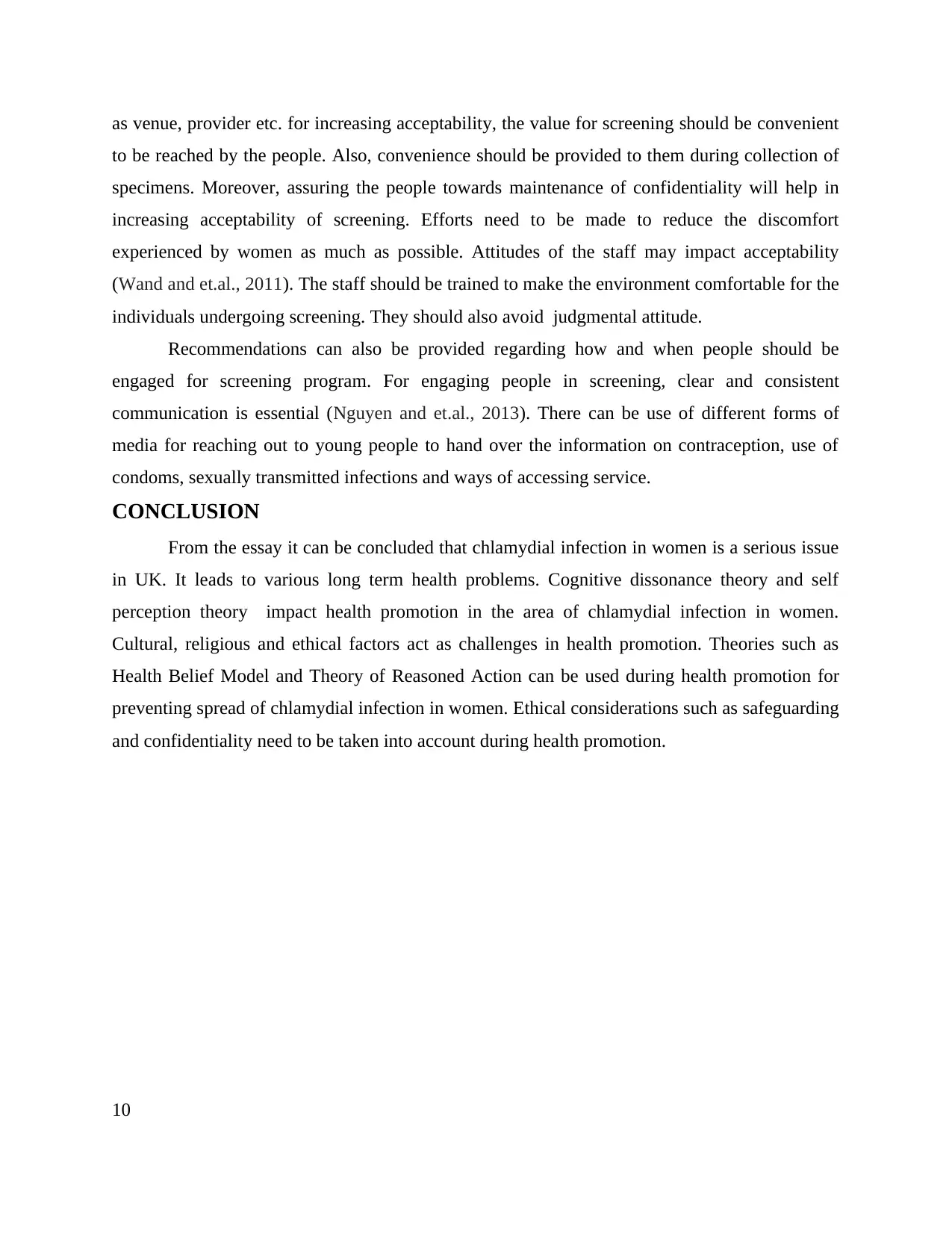
as venue, provider etc. for increasing acceptability, the value for screening should be convenient
to be reached by the people. Also, convenience should be provided to them during collection of
specimens. Moreover, assuring the people towards maintenance of confidentiality will help in
increasing acceptability of screening. Efforts need to be made to reduce the discomfort
experienced by women as much as possible. Attitudes of the staff may impact acceptability
(Wand and et.al., 2011). The staff should be trained to make the environment comfortable for the
individuals undergoing screening. They should also avoid judgmental attitude.
Recommendations can also be provided regarding how and when people should be
engaged for screening program. For engaging people in screening, clear and consistent
communication is essential (Nguyen and et.al., 2013). There can be use of different forms of
media for reaching out to young people to hand over the information on contraception, use of
condoms, sexually transmitted infections and ways of accessing service.
CONCLUSION
From the essay it can be concluded that chlamydial infection in women is a serious issue
in UK. It leads to various long term health problems. Cognitive dissonance theory and self
perception theory impact health promotion in the area of chlamydial infection in women.
Cultural, religious and ethical factors act as challenges in health promotion. Theories such as
Health Belief Model and Theory of Reasoned Action can be used during health promotion for
preventing spread of chlamydial infection in women. Ethical considerations such as safeguarding
and confidentiality need to be taken into account during health promotion.
10
to be reached by the people. Also, convenience should be provided to them during collection of
specimens. Moreover, assuring the people towards maintenance of confidentiality will help in
increasing acceptability of screening. Efforts need to be made to reduce the discomfort
experienced by women as much as possible. Attitudes of the staff may impact acceptability
(Wand and et.al., 2011). The staff should be trained to make the environment comfortable for the
individuals undergoing screening. They should also avoid judgmental attitude.
Recommendations can also be provided regarding how and when people should be
engaged for screening program. For engaging people in screening, clear and consistent
communication is essential (Nguyen and et.al., 2013). There can be use of different forms of
media for reaching out to young people to hand over the information on contraception, use of
condoms, sexually transmitted infections and ways of accessing service.
CONCLUSION
From the essay it can be concluded that chlamydial infection in women is a serious issue
in UK. It leads to various long term health problems. Cognitive dissonance theory and self
perception theory impact health promotion in the area of chlamydial infection in women.
Cultural, religious and ethical factors act as challenges in health promotion. Theories such as
Health Belief Model and Theory of Reasoned Action can be used during health promotion for
preventing spread of chlamydial infection in women. Ethical considerations such as safeguarding
and confidentiality need to be taken into account during health promotion.
10
Secure Best Marks with AI Grader
Need help grading? Try our AI Grader for instant feedback on your assignments.
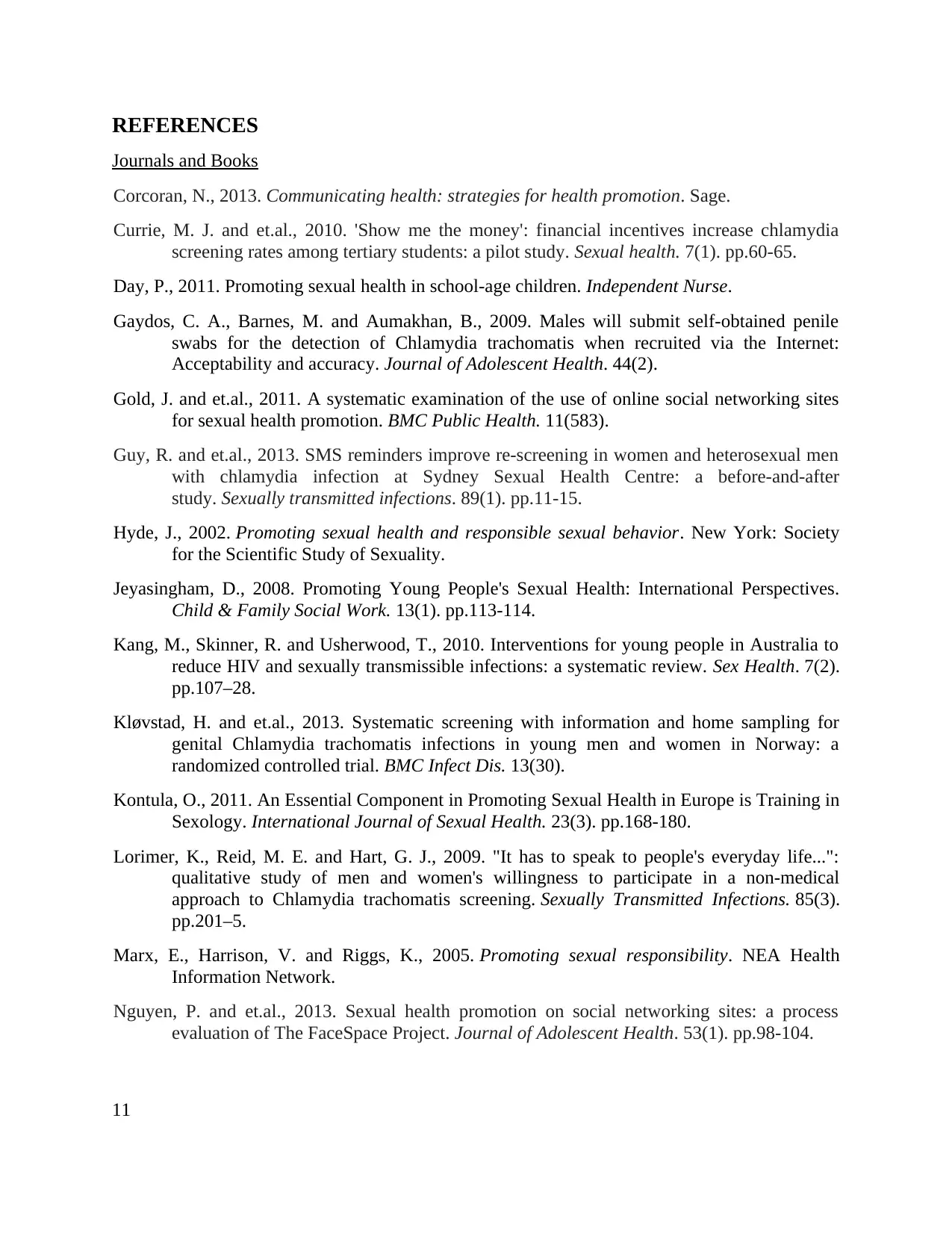
REFERENCES
Journals and Books
Corcoran, N., 2013. Communicating health: strategies for health promotion. Sage.
Currie, M. J. and et.al., 2010. 'Show me the money': financial incentives increase chlamydia
screening rates among tertiary students: a pilot study. Sexual health. 7(1). pp.60-65.
Day, P., 2011. Promoting sexual health in school-age children. Independent Nurse.
Gaydos, C. A., Barnes, M. and Aumakhan, B., 2009. Males will submit self-obtained penile
swabs for the detection of Chlamydia trachomatis when recruited via the Internet:
Acceptability and accuracy. Journal of Adolescent Health. 44(2).
Gold, J. and et.al., 2011. A systematic examination of the use of online social networking sites
for sexual health promotion. BMC Public Health. 11(583).
Guy, R. and et.al., 2013. SMS reminders improve re-screening in women and heterosexual men
with chlamydia infection at Sydney Sexual Health Centre: a before-and-after
study. Sexually transmitted infections. 89(1). pp.11-15.
Hyde, J., 2002. Promoting sexual health and responsible sexual behavior. New York: Society
for the Scientific Study of Sexuality.
Jeyasingham, D., 2008. Promoting Young People's Sexual Health: International Perspectives.
Child & Family Social Work. 13(1). pp.113-114.
Kang, M., Skinner, R. and Usherwood, T., 2010. Interventions for young people in Australia to
reduce HIV and sexually transmissible infections: a systematic review. Sex Health. 7(2).
pp.107–28.
Kløvstad, H. and et.al., 2013. Systematic screening with information and home sampling for
genital Chlamydia trachomatis infections in young men and women in Norway: a
randomized controlled trial. BMC Infect Dis. 13(30).
Kontula, O., 2011. An Essential Component in Promoting Sexual Health in Europe is Training in
Sexology. International Journal of Sexual Health. 23(3). pp.168-180.
Lorimer, K., Reid, M. E. and Hart, G. J., 2009. "It has to speak to people's everyday life...":
qualitative study of men and women's willingness to participate in a non-medical
approach to Chlamydia trachomatis screening. Sexually Transmitted Infections. 85(3).
pp.201–5.
Marx, E., Harrison, V. and Riggs, K., 2005. Promoting sexual responsibility. NEA Health
Information Network.
Nguyen, P. and et.al., 2013. Sexual health promotion on social networking sites: a process
evaluation of The FaceSpace Project. Journal of Adolescent Health. 53(1). pp.98-104.
11
Journals and Books
Corcoran, N., 2013. Communicating health: strategies for health promotion. Sage.
Currie, M. J. and et.al., 2010. 'Show me the money': financial incentives increase chlamydia
screening rates among tertiary students: a pilot study. Sexual health. 7(1). pp.60-65.
Day, P., 2011. Promoting sexual health in school-age children. Independent Nurse.
Gaydos, C. A., Barnes, M. and Aumakhan, B., 2009. Males will submit self-obtained penile
swabs for the detection of Chlamydia trachomatis when recruited via the Internet:
Acceptability and accuracy. Journal of Adolescent Health. 44(2).
Gold, J. and et.al., 2011. A systematic examination of the use of online social networking sites
for sexual health promotion. BMC Public Health. 11(583).
Guy, R. and et.al., 2013. SMS reminders improve re-screening in women and heterosexual men
with chlamydia infection at Sydney Sexual Health Centre: a before-and-after
study. Sexually transmitted infections. 89(1). pp.11-15.
Hyde, J., 2002. Promoting sexual health and responsible sexual behavior. New York: Society
for the Scientific Study of Sexuality.
Jeyasingham, D., 2008. Promoting Young People's Sexual Health: International Perspectives.
Child & Family Social Work. 13(1). pp.113-114.
Kang, M., Skinner, R. and Usherwood, T., 2010. Interventions for young people in Australia to
reduce HIV and sexually transmissible infections: a systematic review. Sex Health. 7(2).
pp.107–28.
Kløvstad, H. and et.al., 2013. Systematic screening with information and home sampling for
genital Chlamydia trachomatis infections in young men and women in Norway: a
randomized controlled trial. BMC Infect Dis. 13(30).
Kontula, O., 2011. An Essential Component in Promoting Sexual Health in Europe is Training in
Sexology. International Journal of Sexual Health. 23(3). pp.168-180.
Lorimer, K., Reid, M. E. and Hart, G. J., 2009. "It has to speak to people's everyday life...":
qualitative study of men and women's willingness to participate in a non-medical
approach to Chlamydia trachomatis screening. Sexually Transmitted Infections. 85(3).
pp.201–5.
Marx, E., Harrison, V. and Riggs, K., 2005. Promoting sexual responsibility. NEA Health
Information Network.
Nguyen, P. and et.al., 2013. Sexual health promotion on social networking sites: a process
evaluation of The FaceSpace Project. Journal of Adolescent Health. 53(1). pp.98-104.
11

Perry, R. C. and et.al., 2012. Adolescents' perspectives on the use of a text messaging service for
preventive sexual health promotion. Journal of adolescent health. 51(3). pp.220-225.
Richardson, D. and et.al., 2010. A pilot qualitative analysis of the psychosocial factors which
drive young people to decline chlamydia testing in the UK: implications for health
promotion and screening. International journal of STD & AIDS. 21(3). pp.187-190.
Wand, H. and et.al., 2011. Developing and validating a risk scoring tool for chlamydia infection
among sexual health clinic attendees in Australia: a simple algorithm to identify those at
high risk of chlamydia infection. BMJ open. 1(1).
Woodhall, S. C. and et.al., 2012. Internet testing for Chlamydia trachomatis in England, 2006 to
2010. BMC Public Health. 12(1). p.1095.
Online
Chlamydia In Women. 2015. [Online]. Available through:
<https://www.dred.com/uk/chlamydia-symptoms-in-women.html>. [Accessed on 5
December 2015].
Chlamydia Statistics for the UK in 2014. 2014. [Online]. Available through:
<http://www.stdtreatmentuk.com/chlamydia-statistics-for-the-uk-in-2014/>. [Accessed on
5 December 2015].
Coleman, E., 2015. Working Toward Sexual Health Promotion. [Online]. Available through:
<http://www.ashasexualhealth.org/working-toward-sexual-health-promotion/>. [Accessed
on 5 December 2015].
Infection report. 2015. [Online]. Available through:
<https://www.gov.uk/government/uploads/system/uploads/attachment_data/file/437433/
hpr2215_STI_NCSP_v6.pdf>. [Accessed on 4 December 2015].
Tackling chlamydia. 2013. [Online]. Available through:
<http://www.local.gov.uk/documents/10180/5854661/L14-637+-+Tackling+chlamydia+-
+Local+government's+new+public+role/cbc62b57-9e9f-4409-8a25-d771a58e861c>.
[Accessed on 4 December 2015].
12
preventive sexual health promotion. Journal of adolescent health. 51(3). pp.220-225.
Richardson, D. and et.al., 2010. A pilot qualitative analysis of the psychosocial factors which
drive young people to decline chlamydia testing in the UK: implications for health
promotion and screening. International journal of STD & AIDS. 21(3). pp.187-190.
Wand, H. and et.al., 2011. Developing and validating a risk scoring tool for chlamydia infection
among sexual health clinic attendees in Australia: a simple algorithm to identify those at
high risk of chlamydia infection. BMJ open. 1(1).
Woodhall, S. C. and et.al., 2012. Internet testing for Chlamydia trachomatis in England, 2006 to
2010. BMC Public Health. 12(1). p.1095.
Online
Chlamydia In Women. 2015. [Online]. Available through:
<https://www.dred.com/uk/chlamydia-symptoms-in-women.html>. [Accessed on 5
December 2015].
Chlamydia Statistics for the UK in 2014. 2014. [Online]. Available through:
<http://www.stdtreatmentuk.com/chlamydia-statistics-for-the-uk-in-2014/>. [Accessed on
5 December 2015].
Coleman, E., 2015. Working Toward Sexual Health Promotion. [Online]. Available through:
<http://www.ashasexualhealth.org/working-toward-sexual-health-promotion/>. [Accessed
on 5 December 2015].
Infection report. 2015. [Online]. Available through:
<https://www.gov.uk/government/uploads/system/uploads/attachment_data/file/437433/
hpr2215_STI_NCSP_v6.pdf>. [Accessed on 4 December 2015].
Tackling chlamydia. 2013. [Online]. Available through:
<http://www.local.gov.uk/documents/10180/5854661/L14-637+-+Tackling+chlamydia+-
+Local+government's+new+public+role/cbc62b57-9e9f-4409-8a25-d771a58e861c>.
[Accessed on 4 December 2015].
12
1 out of 12
Related Documents
Your All-in-One AI-Powered Toolkit for Academic Success.
+13062052269
info@desklib.com
Available 24*7 on WhatsApp / Email
![[object Object]](/_next/static/media/star-bottom.7253800d.svg)
Unlock your academic potential
© 2024 | Zucol Services PVT LTD | All rights reserved.





